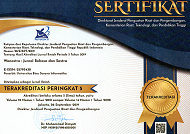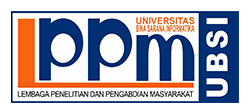Short Movie in EFL Classroom: EFL Learners’ English Speaking Achievement
Abstract
Integrating short movies seems to be interesting and exciting in English speaking classroom. This inquiry was aimed at investigating the effect of short movies with retelling technique on English speaking achievement. Six research questions were tailored to predict. A quasi-experimental research design which was merely concerned on comparison group research design was used in this research. Purposive sampling was employed in which it consisted of twenty eight participants with equal size comprising of fourteen participants, respectively. An English speaking assessment as the instrumentation was performed with analytical scoring rubric used to collect the data of EFL learners’ speaking performance. The research process was successfully done to answer predicted six research questions. In conclusion, using short movie with retelling technique gave significant improvement on EFL learners’ English speaking analytically and holistically as the p value was lower than conventional level of significance. Besides, the percentage distribution to respective aspect of speaking was fluency (88.7%), vocabulary (7.5%), pronunciation (2.1%), comprehension (.7%), and grammar (.6%). Some thorough and systematic conclusions and pedagogical implications were tactfully written out.
Key words: short movie, EFL classroom, retelling technique, English speaking achievement
Full Text:
PDFReferences
Albiladi, W. S., Abdeen, F. H., & Lincoln, F. (2018). Learning English through movies: Adult English language learners’ perceptions. Theory and Practice in Language Studies, 8(12), 1567. https://doi.org/10.17507/tpls.0812.01
Alluri, P. (2018). Enhancing English language teaching through films in general foundation programs. Arab World English Journal, 1, 146–154. https://doi.org/10.24093/awej/mec1.11
Al Murshidi (2020). Effectiveness of movies in teaching and learning English as a Foreign Language at universities in UAE. Psychology and Education, 57(6), 442-450. https://doi.org/10.17762/pae.v57i6.50
Amalia, S., & Apriani, D. (2016). Project-based instruction: Integrating technology in speaking instruction. The English Teacher, 45(2), 64–73. https://meltajournals.com/index.php/TET/article/view/71
Ambarita, et al (2022). Improving students’ ability in speaking through animation movie. Philology: Journal of English Language and Literature 2 (2), 85-90. https://doi.org/10.32696/pjell.v2i2.1351
Anwar, A., Derin, T., Nursafira, M. S., Putri, N. S., & Jazzawi, I. (2020). Delivering positive message through #BaliAman Vlog: President Joko Widodo’s communication strategy. Journal of Election and Leadership, 1(1), 57-63. https://doi.org/10.31849/joels.v1i1.3402
Blasco, P. G., Moreto, G., Blasco, M. G., Levites, M. R., & Janaudis, M. A. (2015). Education through movies: Improving teaching skills and fostering reflection among students and teachers. Journal for Learning through the Arts, 11(1), 1-16. https://doi.org/10.21977/D911122357
Chaya, P., & Inpin, B. (2020). Effects of integrating movie-based mobile learning instruction for enhancing Thai university students’ speaking skills and intercultural communicative competence. English Language Teaching, 13(7), 27–45. https://doi.org/10.5539/elt.v13n7p27
DeLozier, S. J., & Rhodes, M. G. (2017). Flipped classrooms: A review of key ideas and recommendations for practice. Educational Psychology Review, 29(1), 141–151. https://doi.org/10.1007/s10648-015-9356-9
Fitri, S., Komariah, E., & Heriansyah, H., (2017). Improving students’ speaking skill by retelling technique using video (An experimental study at the second grade students of MTsN Kuta Baro Aceh Besar). Research in English and Education (READ), 2(3), 36-45. https://jim.usk.ac.id/READ/article/view/7163
Goctu, R. (2017). Using movies in EFL classrooms. European Journal of Language and Literature Studies, 3(2), 121–124. https://doi.org/10.26417/ejls.v8i1.p121-124
Iftanti, E., & Maunah, B. (2021). Belief, perception, and challenges of non-English department students to learn English in globalization era. Indonesian EFL Journal, 7(1), 1–12. https://doi.org/10.25134/ieflj.v7i1.3985
Iman, J. N (2017). Debate Instruction in EFL Classroom: Impacts on the critical thinking and speaking skill. International Journal of Instruction, 10(4), 87-108. https://doi.org/10.12973/iji.2017.1046a
Irmanda, I., Ahmad, Y. B., & al Baekani, A. K. (2021). Students’ perspectives towards English short movies as media to assist their vocabulary mastery in online learning. Edukatif : Jurnal Ilmu Pendidikan, 3(4), 2081–2091. https://doi.org/10.31004/edukatif.v3i4.1151
Islam, W., Ahmad, S., & Islam, Md. D. (2022). Investigating the problems faced by the university EFL learners in speaking English language. International Journal of TESOL & Education, 2(2), 47–65. https://doi.org/10.54855/ijte.22223.
Kabooha, R. H. (2016). Using movies in EFL classrooms: A study conducted at the English Language Institute (ELI), King Abdul-Aziz University. English Language Teaching, 9(3), 248. https://doi.org/10.5539/elt.v9n3p248
Kanellopoulou, C. (2019). Film subtitles as a successful vocabulary learning tool. Open Journal of Modern Linguistics, 9(2), 145–152. https://doi.org/10.4236/ojml.2019.92014
King, J. (2002). Using DVD feature films in the EFL Classroom. Computer Assisted Language Learning, 15(5), 509-523. https://doi.org/10.1076/call.15.5.509.13468
Khan, A. (2015). Using films in the ESL classroom to improve communication skills of non-native learners. ELT Voices- International Journal for Teachers of English, 5(4), 46–52. https://www.scribd.com/document/538758171/Using-Films-in-the-ESL-Classroom-to-Improve-Communication-Skills-of-Non-native-Learners
Kusumawati, E. (2019). The effect of watching English movies with subtitles on ESP students’ content and vocabulary comprehension. A study conducted at an Indonesia polytechnic Engineering. Science, Engineering, Education, and Development Studies (SEEDS): Conference Series, 2(2). https://jurnal.uns.ac.id/seeds/article/view/27514
Laiya, R. E. (2020). Application of critical thinking on the social media (case study comments and statuses on Facebook about miss tourism competition on West Nias). Journal of Physics: Conference Series 1477, (4), 042002. IOP Publishing. https://www.researchgate. net/publication/340652909_Application_of_Critical_Thinking_on_the_Social_Media_Case_Study_ Comments_ and_Statuses_on_Facebook_about_Miss_Tourism_Competition_ on_West_Nias
Li, X. H. , & Wang. P. (2015). A research on using English movies to improve Chinese college students’ oral English. Theory and Practice in Language Studies, 5(5), 1096-1100. https://doi.org/10.17507/TPLS.0505.26
Liando, N. V., Sahetapy, R. J., & Maru, M. G. (2018). English major students’ perceptions towards watching English movies in listening and speaking skills development. Advances in Social Sciences Research Journal, 5(6) https://doi.org/10.14738/assrj.56.4627
Madiyoh, R., Hidayanto, N., & Putro, P. S. (2018). The effectiveness of authentic short movies in enhancing students speaking skill. International Journal of English Literature and Culture, 6(3), 44–49. https://doi.org/10.14662/IJELC2018.030
Masruddin, M. (2018). The efficacy of using short video through group work in teaching speaking to Indonesian English as foreign language (EFL) students. Arab World English Journal, 9(3), 282–293. https://doi.org/10.24093/awej/vol9no 3.19
Meinawati, E., Harmoko, D. D., Rahmah, N. A., & Dewi, N. (2020). Increasing English speaking skills using Youtube. Polyglot: Jurnal Ilmiah, 16(1), 1. https://doi.org/10.19166/pji.v16i1.1954
Metruk, R. (2018). The effects of watching authentic English videos with and without subtitles on listening and reading skills of EFL learners. EURASIA Journal of Mathematics, Science and Technology Education, 14(6), 2545–2553.
Park, Y. & Jung, E. (2016). Exploring the use of video-clips for motivation building in a secondary school EFL setting. English Language Teaching, 9(10), 81-89. Retrieved from http://files.eric.ed.gov.ezproxy.uwplatt.edu/fulltext/EJ1113509.pdf
Pitaksuksan, N., & Sinwongsuwat, K. (2020). CA-informed interactional feature analysis of conversations in textbooks used for teaching English speaking in Thai secondary schools. English Language Teaching, 13(7), 140. https://doi.org/10.5539/elt.v13n7p140
Putri, N. S. (2019). Kahoot Application in English Language Teaching (ELT) context: An alternative learning strategy. Elsya: Journal of English Language Studies, 1(1), 11-15. https://doi.org/10.31849/elsya.v1i1.2488
Rao, P. S. (2019). The impact of English movies on learning English in ESL/EFL classrooms. Research Journal of English Language and Literature (RJELAL), 7(4), 430–438. https://doi.org/10.33329/rjelal.74.430.
Rayhan, J. M. (2014). The impact of using role play techniques on improving pupils’ speaking skill for primary school. Journal of Basic Education, 15, 516–530. https://www.iraqoaj.net/iasj/article/91556
Riswanto., Serasi, R., Salandega, A., & Kasmaini. (2022). The effect of fiction short movie on students’ English speaking ability. English Review: Journal of English Education, 10(2), 621-628. https://doi.org/10.25134/erjee.v10i2.6282.
Smaldino, S., Lowther, D., & Russell, J. (2012). Instructional technology and media for learning. Boston, MA: Pearson. Pearson.
Tajgozari, M. (2019). The effect of watching captioned TV series on speaking accuracy of Iranian advanced EFL learners. Global Journal of Foreign Language Teaching, 9(3), 157–166. https://doi.org/10.18844/gjflt.v9i3.4221
Tnomat, Densiana., Billik, M. O., & Banu, T. B. J. (2022). The implementation of short English movie to improve students’ vocabulary mastery in interpretive listening class. Saga: Journal of English Language Teaching and Applied Linguistics, 3(1), 59–68. https://doi.org/10.21460/saga.2022.32.121
Tuan, N. H., & Mai, T. N. (2015). Factors affecting students’ speaking performance at LE Thanh Hien High School. Asian Journal of Educational Research, 3(2), 8 -23. https://multidisciplinaryjournals.com/ajer-vol-3-no-2-2015/
Usmonov, A. Q., & Usmonova, U. B. (2020). Linguopragmatic characteristics of the Uzbek language equivalent. Theoretical & Applied Science, 5, 855–858. https://www.t-science.org/arxivDOI/2020/05-85/PDF/05-85-158.pdf
Wang, Y., & Zhang, H. F. (2012). The application of English movies in higher vocational English teaching. Sin-US English Teaching, 9(3), 1010-1014. Retrieved from http://www.davidpublishing.com/davidpublishing/Upfile/6/3/2012/2012060366725149.pdf
Wulandari, N. A., Amalia, S., & Ramdhani, M. I. (2022). Investigating speaking difficulties of senior high school students: Linguistics and psychological problems. English Franca: Academic Journal of English Language and Education, 6(1), 151–166. https://doi.org/10.29240/ef.v6i1.4271
Yaseen, B. H., & Shakir, H. (2015). Movie effects on EFL learners at Iraqi school in Kuala Lumpur. International Journal of Education and Literacy Studies, 3(3), 31–36. https://doi.org/10.7575/aiac.ijels.v.3n.3p.31
Zarifa, I. (2020). The importance of speaking skill in the classroom. In Proceedings of 3rd International Multidisciplinary Scientific Conference on Innovative Technology (Ed.), Proceeding of 3rd International Multidisciplinary Scientific Conference on Innovative Technology (pp. 3–4). https://conferencepublication.com.
DOI: https://doi.org/10.31294/wanastra.v17i2.26753
Copyright (c) 2025 Jaya Nur Iman

This work is licensed under a Creative Commons Attribution-ShareAlike 4.0 International License.
Index by:
| | | |
Published by Department of Research and Public Service (LPPM) Universitas Bina Sarana Informatika with supported Relawan Jurnal Indonesia
Kramat Raya Street No.98, Kwitang, Kec. Senen, Central Jakarta, DKI Jakarta 10450

This work is licensed under a Creative Commons Attribution-ShareAlike 4.0 International License







